Report: Analysis of Business Structures in Australia (BUS101, S1 2024)
VerifiedAdded on 2022/10/17
|8
|1837
|11
Report
AI Summary
This report provides a comprehensive overview of different business structures prevalent in Australia. It begins by introducing the concept of business structures and their importance, then delves into detailed analyses of sole trader, partnership, company, and trust structures. For each structure, the report outlines key characteristics, advantages, and disadvantages, including aspects like liability, taxation, compliance requirements, and ease of establishment. The analysis covers the legal framework and relevant legislation, such as the Corporations Act 2001 (Cth) and Partnership Act 1891 (Qld). The report also discusses the limited liability partnership (LLP) as an advanced form of partnership. The report concludes by emphasizing the significance of carefully selecting the appropriate business structure based on individual business needs and objectives. It also includes a detailed list of references used in the research.

Introduction to Business and Law
7/29/2019
Student’s Name
7/29/2019
Student’s Name
Paraphrase This Document
Need a fresh take? Get an instant paraphrase of this document with our AI Paraphraser
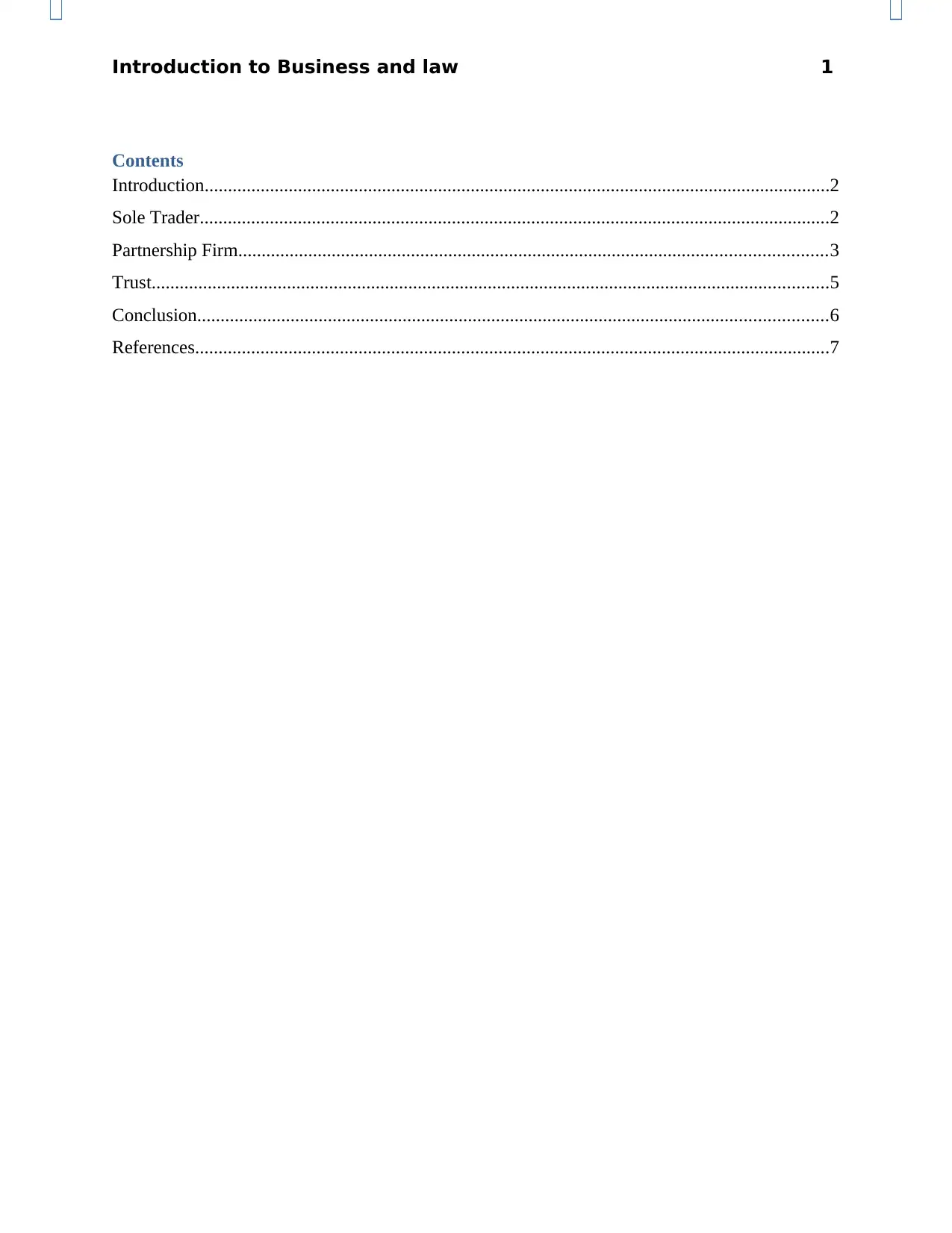
Introduction to Business and law 1
Contents
Introduction......................................................................................................................................2
Sole Trader.......................................................................................................................................2
Partnership Firm..............................................................................................................................3
Trust.................................................................................................................................................5
Conclusion.......................................................................................................................................6
References........................................................................................................................................7
Contents
Introduction......................................................................................................................................2
Sole Trader.......................................................................................................................................2
Partnership Firm..............................................................................................................................3
Trust.................................................................................................................................................5
Conclusion.......................................................................................................................................6
References........................................................................................................................................7
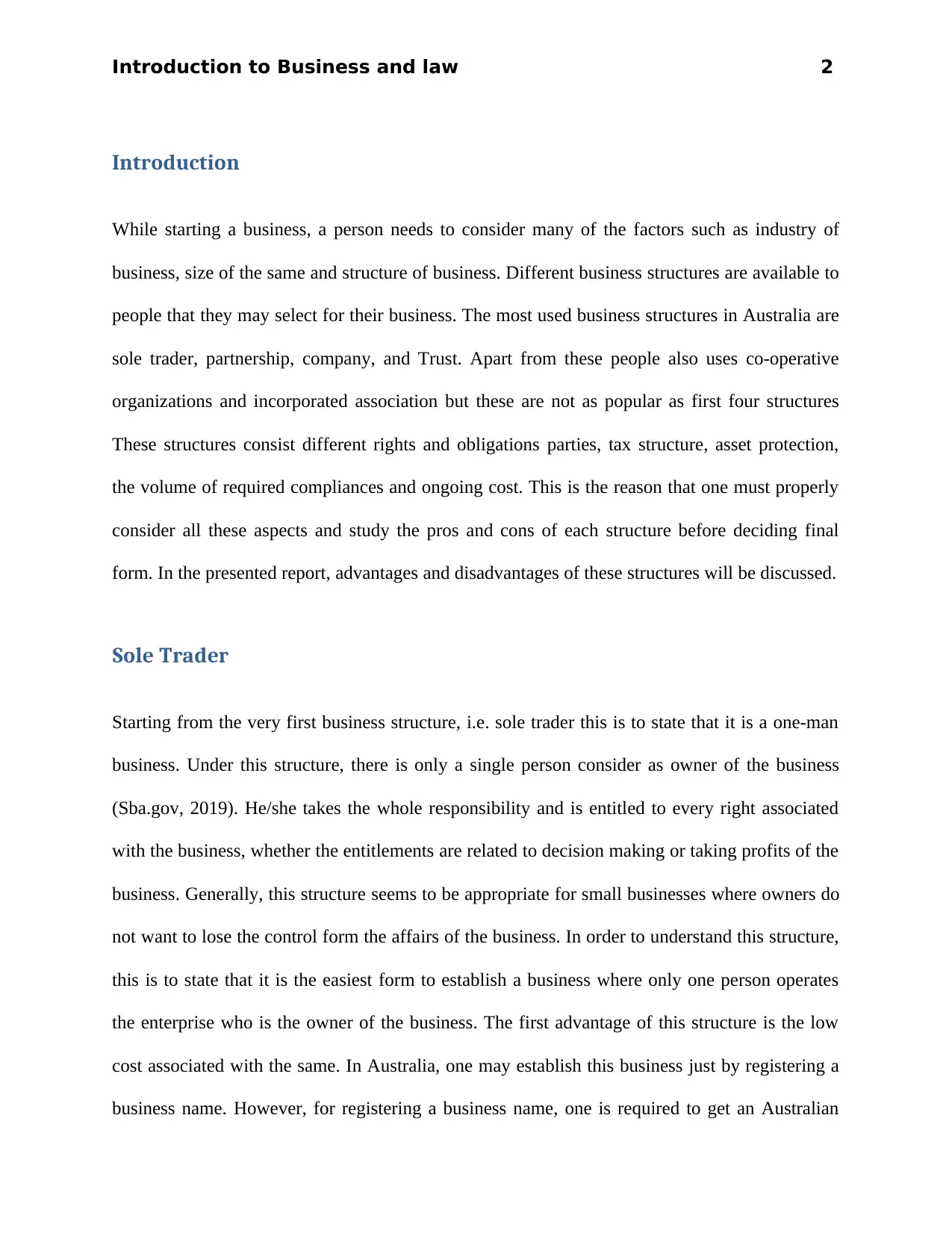
Introduction to Business and law 2
Introduction
While starting a business, a person needs to consider many of the factors such as industry of
business, size of the same and structure of business. Different business structures are available to
people that they may select for their business. The most used business structures in Australia are
sole trader, partnership, company, and Trust. Apart from these people also uses co-operative
organizations and incorporated association but these are not as popular as first four structures
These structures consist different rights and obligations parties, tax structure, asset protection,
the volume of required compliances and ongoing cost. This is the reason that one must properly
consider all these aspects and study the pros and cons of each structure before deciding final
form. In the presented report, advantages and disadvantages of these structures will be discussed.
Sole Trader
Starting from the very first business structure, i.e. sole trader this is to state that it is a one-man
business. Under this structure, there is only a single person consider as owner of the business
(Sba.gov, 2019). He/she takes the whole responsibility and is entitled to every right associated
with the business, whether the entitlements are related to decision making or taking profits of the
business. Generally, this structure seems to be appropriate for small businesses where owners do
not want to lose the control form the affairs of the business. In order to understand this structure,
this is to state that it is the easiest form to establish a business where only one person operates
the enterprise who is the owner of the business. The first advantage of this structure is the low
cost associated with the same. In Australia, one may establish this business just by registering a
business name. However, for registering a business name, one is required to get an Australian
Introduction
While starting a business, a person needs to consider many of the factors such as industry of
business, size of the same and structure of business. Different business structures are available to
people that they may select for their business. The most used business structures in Australia are
sole trader, partnership, company, and Trust. Apart from these people also uses co-operative
organizations and incorporated association but these are not as popular as first four structures
These structures consist different rights and obligations parties, tax structure, asset protection,
the volume of required compliances and ongoing cost. This is the reason that one must properly
consider all these aspects and study the pros and cons of each structure before deciding final
form. In the presented report, advantages and disadvantages of these structures will be discussed.
Sole Trader
Starting from the very first business structure, i.e. sole trader this is to state that it is a one-man
business. Under this structure, there is only a single person consider as owner of the business
(Sba.gov, 2019). He/she takes the whole responsibility and is entitled to every right associated
with the business, whether the entitlements are related to decision making or taking profits of the
business. Generally, this structure seems to be appropriate for small businesses where owners do
not want to lose the control form the affairs of the business. In order to understand this structure,
this is to state that it is the easiest form to establish a business where only one person operates
the enterprise who is the owner of the business. The first advantage of this structure is the low
cost associated with the same. In Australia, one may establish this business just by registering a
business name. However, for registering a business name, one is required to get an Australian
⊘ This is a preview!⊘
Do you want full access?
Subscribe today to unlock all pages.

Trusted by 1+ million students worldwide
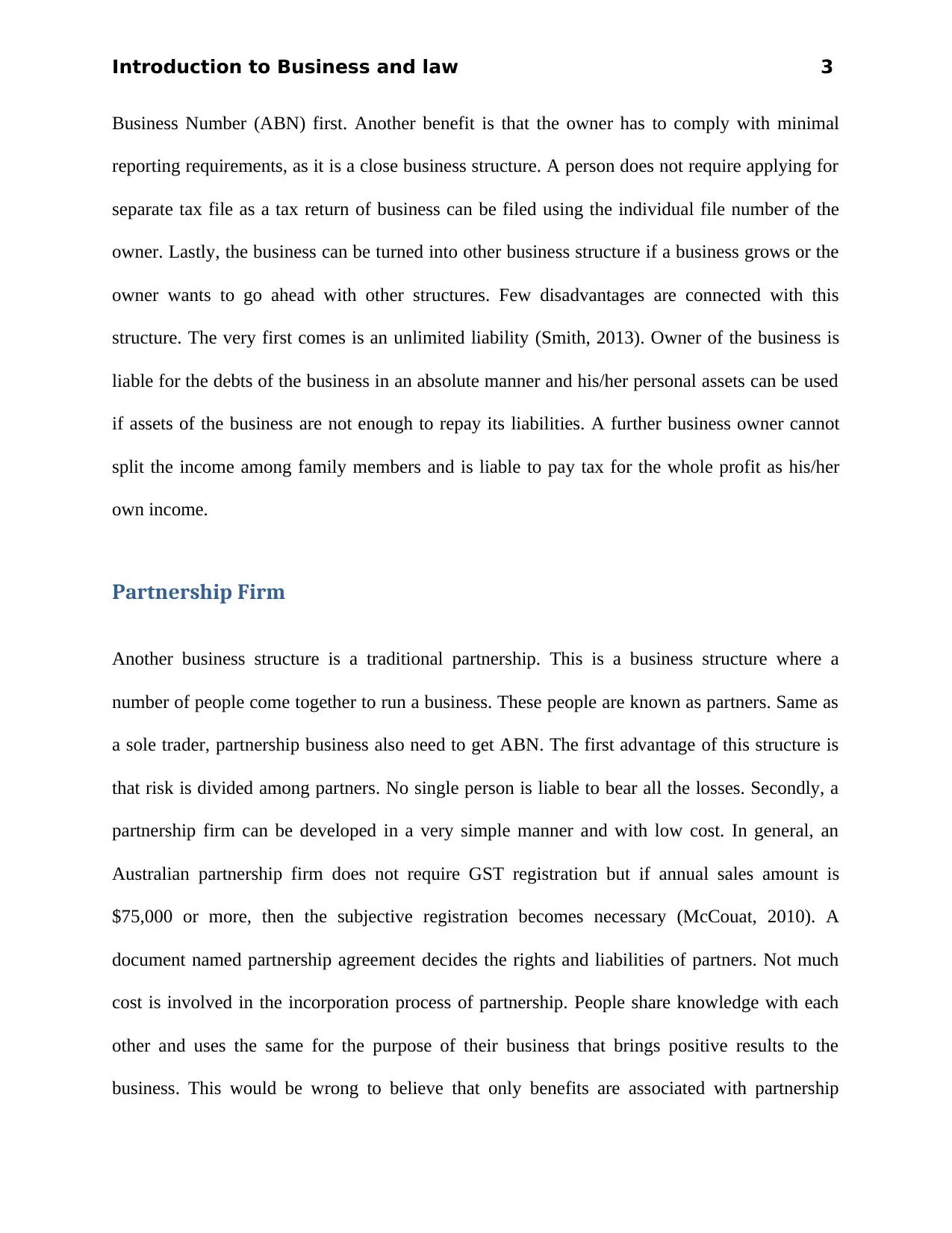
Introduction to Business and law 3
Business Number (ABN) first. Another benefit is that the owner has to comply with minimal
reporting requirements, as it is a close business structure. A person does not require applying for
separate tax file as a tax return of business can be filed using the individual file number of the
owner. Lastly, the business can be turned into other business structure if a business grows or the
owner wants to go ahead with other structures. Few disadvantages are connected with this
structure. The very first comes is an unlimited liability (Smith, 2013). Owner of the business is
liable for the debts of the business in an absolute manner and his/her personal assets can be used
if assets of the business are not enough to repay its liabilities. A further business owner cannot
split the income among family members and is liable to pay tax for the whole profit as his/her
own income.
Partnership Firm
Another business structure is a traditional partnership. This is a business structure where a
number of people come together to run a business. These people are known as partners. Same as
a sole trader, partnership business also need to get ABN. The first advantage of this structure is
that risk is divided among partners. No single person is liable to bear all the losses. Secondly, a
partnership firm can be developed in a very simple manner and with low cost. In general, an
Australian partnership firm does not require GST registration but if annual sales amount is
$75,000 or more, then the subjective registration becomes necessary (McCouat, 2010). A
document named partnership agreement decides the rights and liabilities of partners. Not much
cost is involved in the incorporation process of partnership. People share knowledge with each
other and uses the same for the purpose of their business that brings positive results to the
business. This would be wrong to believe that only benefits are associated with partnership
Business Number (ABN) first. Another benefit is that the owner has to comply with minimal
reporting requirements, as it is a close business structure. A person does not require applying for
separate tax file as a tax return of business can be filed using the individual file number of the
owner. Lastly, the business can be turned into other business structure if a business grows or the
owner wants to go ahead with other structures. Few disadvantages are connected with this
structure. The very first comes is an unlimited liability (Smith, 2013). Owner of the business is
liable for the debts of the business in an absolute manner and his/her personal assets can be used
if assets of the business are not enough to repay its liabilities. A further business owner cannot
split the income among family members and is liable to pay tax for the whole profit as his/her
own income.
Partnership Firm
Another business structure is a traditional partnership. This is a business structure where a
number of people come together to run a business. These people are known as partners. Same as
a sole trader, partnership business also need to get ABN. The first advantage of this structure is
that risk is divided among partners. No single person is liable to bear all the losses. Secondly, a
partnership firm can be developed in a very simple manner and with low cost. In general, an
Australian partnership firm does not require GST registration but if annual sales amount is
$75,000 or more, then the subjective registration becomes necessary (McCouat, 2010). A
document named partnership agreement decides the rights and liabilities of partners. Not much
cost is involved in the incorporation process of partnership. People share knowledge with each
other and uses the same for the purpose of their business that brings positive results to the
business. This would be wrong to believe that only benefits are associated with partnership
Paraphrase This Document
Need a fresh take? Get an instant paraphrase of this document with our AI Paraphraser
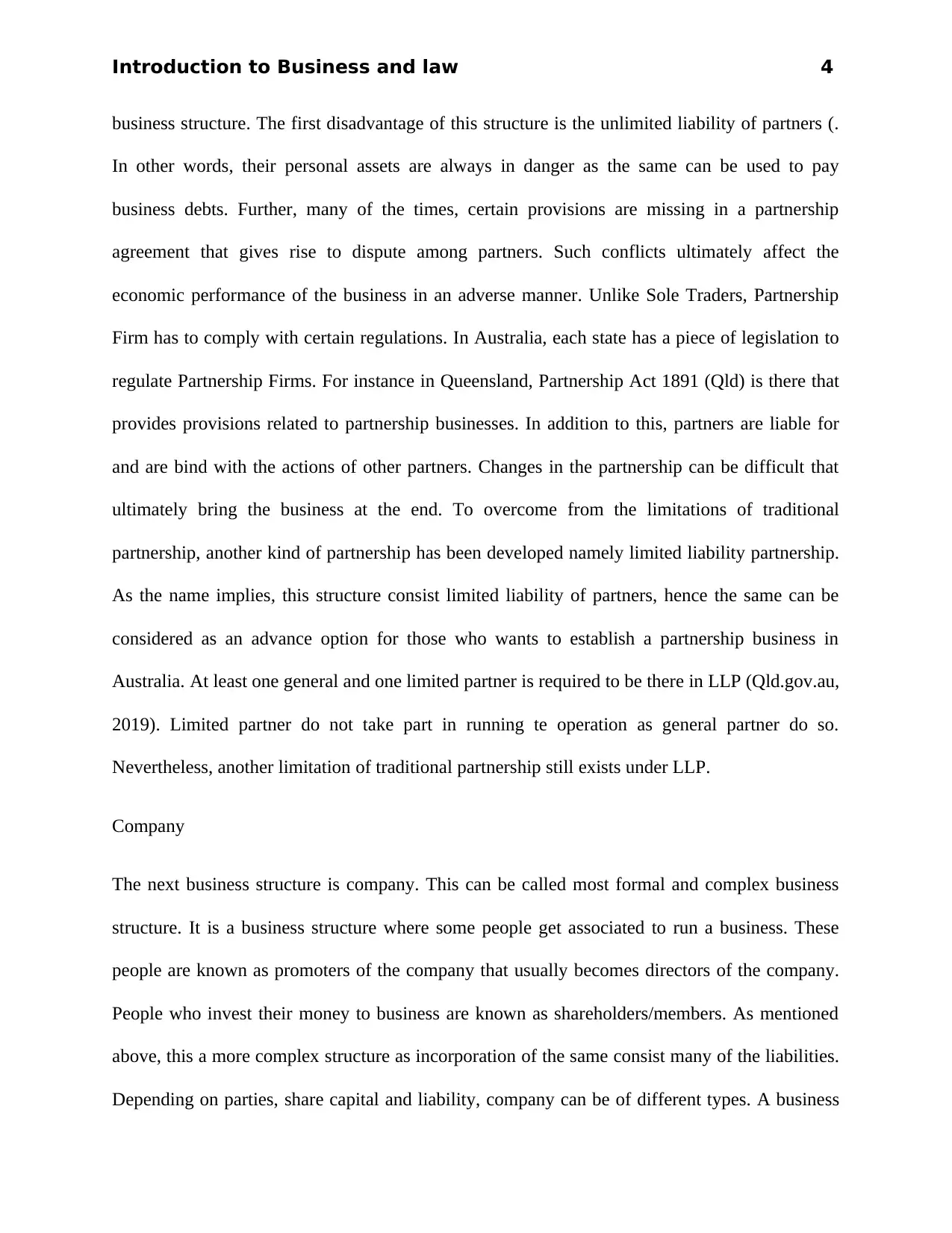
Introduction to Business and law 4
business structure. The first disadvantage of this structure is the unlimited liability of partners (.
In other words, their personal assets are always in danger as the same can be used to pay
business debts. Further, many of the times, certain provisions are missing in a partnership
agreement that gives rise to dispute among partners. Such conflicts ultimately affect the
economic performance of the business in an adverse manner. Unlike Sole Traders, Partnership
Firm has to comply with certain regulations. In Australia, each state has a piece of legislation to
regulate Partnership Firms. For instance in Queensland, Partnership Act 1891 (Qld) is there that
provides provisions related to partnership businesses. In addition to this, partners are liable for
and are bind with the actions of other partners. Changes in the partnership can be difficult that
ultimately bring the business at the end. To overcome from the limitations of traditional
partnership, another kind of partnership has been developed namely limited liability partnership.
As the name implies, this structure consist limited liability of partners, hence the same can be
considered as an advance option for those who wants to establish a partnership business in
Australia. At least one general and one limited partner is required to be there in LLP (Qld.gov.au,
2019). Limited partner do not take part in running te operation as general partner do so.
Nevertheless, another limitation of traditional partnership still exists under LLP.
Company
The next business structure is company. This can be called most formal and complex business
structure. It is a business structure where some people get associated to run a business. These
people are known as promoters of the company that usually becomes directors of the company.
People who invest their money to business are known as shareholders/members. As mentioned
above, this a more complex structure as incorporation of the same consist many of the liabilities.
Depending on parties, share capital and liability, company can be of different types. A business
business structure. The first disadvantage of this structure is the unlimited liability of partners (.
In other words, their personal assets are always in danger as the same can be used to pay
business debts. Further, many of the times, certain provisions are missing in a partnership
agreement that gives rise to dispute among partners. Such conflicts ultimately affect the
economic performance of the business in an adverse manner. Unlike Sole Traders, Partnership
Firm has to comply with certain regulations. In Australia, each state has a piece of legislation to
regulate Partnership Firms. For instance in Queensland, Partnership Act 1891 (Qld) is there that
provides provisions related to partnership businesses. In addition to this, partners are liable for
and are bind with the actions of other partners. Changes in the partnership can be difficult that
ultimately bring the business at the end. To overcome from the limitations of traditional
partnership, another kind of partnership has been developed namely limited liability partnership.
As the name implies, this structure consist limited liability of partners, hence the same can be
considered as an advance option for those who wants to establish a partnership business in
Australia. At least one general and one limited partner is required to be there in LLP (Qld.gov.au,
2019). Limited partner do not take part in running te operation as general partner do so.
Nevertheless, another limitation of traditional partnership still exists under LLP.
Company
The next business structure is company. This can be called most formal and complex business
structure. It is a business structure where some people get associated to run a business. These
people are known as promoters of the company that usually becomes directors of the company.
People who invest their money to business are known as shareholders/members. As mentioned
above, this a more complex structure as incorporation of the same consist many of the liabilities.
Depending on parties, share capital and liability, company can be of different types. A business
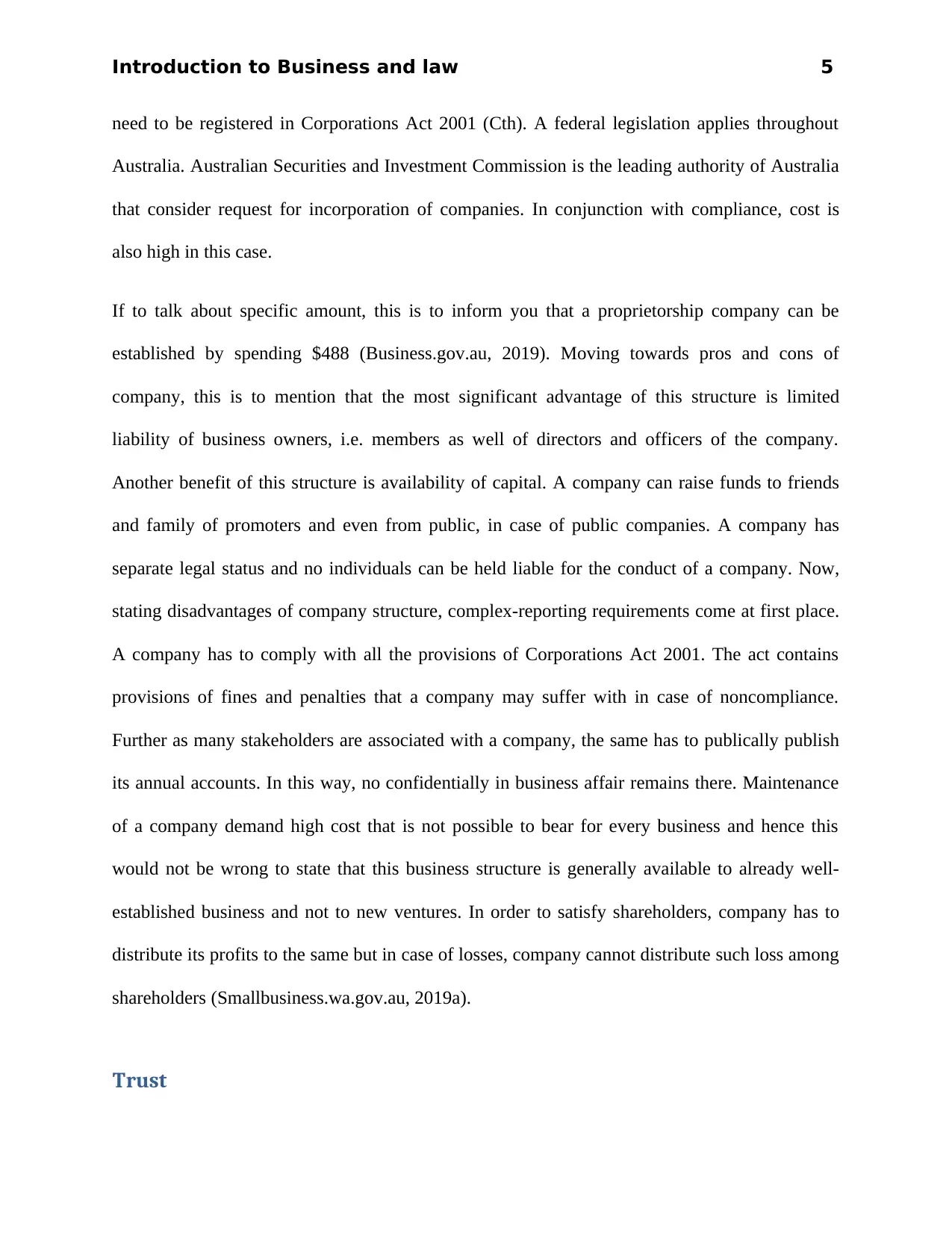
Introduction to Business and law 5
need to be registered in Corporations Act 2001 (Cth). A federal legislation applies throughout
Australia. Australian Securities and Investment Commission is the leading authority of Australia
that consider request for incorporation of companies. In conjunction with compliance, cost is
also high in this case.
If to talk about specific amount, this is to inform you that a proprietorship company can be
established by spending $488 (Business.gov.au, 2019). Moving towards pros and cons of
company, this is to mention that the most significant advantage of this structure is limited
liability of business owners, i.e. members as well of directors and officers of the company.
Another benefit of this structure is availability of capital. A company can raise funds to friends
and family of promoters and even from public, in case of public companies. A company has
separate legal status and no individuals can be held liable for the conduct of a company. Now,
stating disadvantages of company structure, complex-reporting requirements come at first place.
A company has to comply with all the provisions of Corporations Act 2001. The act contains
provisions of fines and penalties that a company may suffer with in case of noncompliance.
Further as many stakeholders are associated with a company, the same has to publically publish
its annual accounts. In this way, no confidentially in business affair remains there. Maintenance
of a company demand high cost that is not possible to bear for every business and hence this
would not be wrong to state that this business structure is generally available to already well-
established business and not to new ventures. In order to satisfy shareholders, company has to
distribute its profits to the same but in case of losses, company cannot distribute such loss among
shareholders (Smallbusiness.wa.gov.au, 2019a).
Trust
need to be registered in Corporations Act 2001 (Cth). A federal legislation applies throughout
Australia. Australian Securities and Investment Commission is the leading authority of Australia
that consider request for incorporation of companies. In conjunction with compliance, cost is
also high in this case.
If to talk about specific amount, this is to inform you that a proprietorship company can be
established by spending $488 (Business.gov.au, 2019). Moving towards pros and cons of
company, this is to mention that the most significant advantage of this structure is limited
liability of business owners, i.e. members as well of directors and officers of the company.
Another benefit of this structure is availability of capital. A company can raise funds to friends
and family of promoters and even from public, in case of public companies. A company has
separate legal status and no individuals can be held liable for the conduct of a company. Now,
stating disadvantages of company structure, complex-reporting requirements come at first place.
A company has to comply with all the provisions of Corporations Act 2001. The act contains
provisions of fines and penalties that a company may suffer with in case of noncompliance.
Further as many stakeholders are associated with a company, the same has to publically publish
its annual accounts. In this way, no confidentially in business affair remains there. Maintenance
of a company demand high cost that is not possible to bear for every business and hence this
would not be wrong to state that this business structure is generally available to already well-
established business and not to new ventures. In order to satisfy shareholders, company has to
distribute its profits to the same but in case of losses, company cannot distribute such loss among
shareholders (Smallbusiness.wa.gov.au, 2019a).
Trust
⊘ This is a preview!⊘
Do you want full access?
Subscribe today to unlock all pages.

Trusted by 1+ million students worldwide
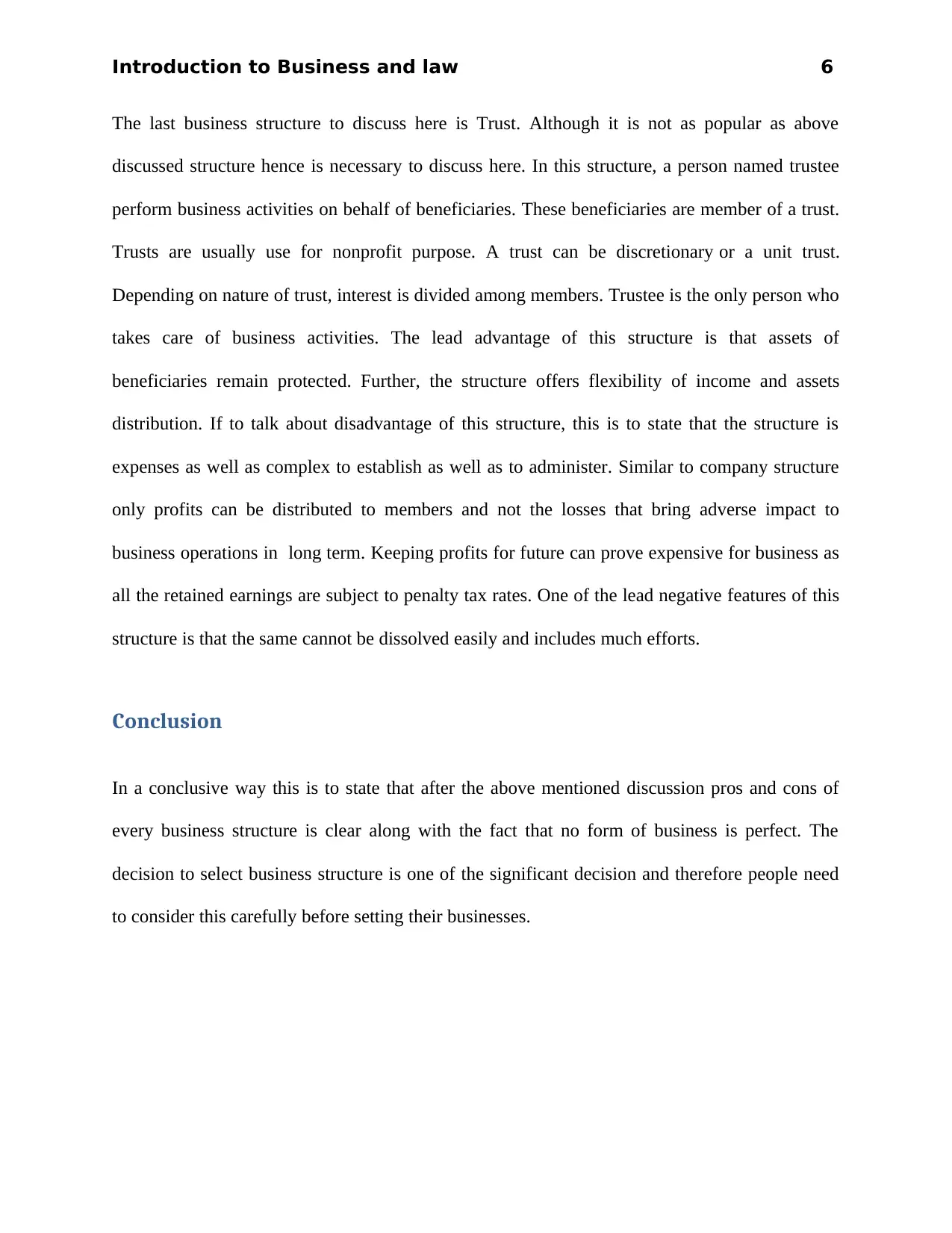
Introduction to Business and law 6
The last business structure to discuss here is Trust. Although it is not as popular as above
discussed structure hence is necessary to discuss here. In this structure, a person named trustee
perform business activities on behalf of beneficiaries. These beneficiaries are member of a trust.
Trusts are usually use for nonprofit purpose. A trust can be discretionary or a unit trust.
Depending on nature of trust, interest is divided among members. Trustee is the only person who
takes care of business activities. The lead advantage of this structure is that assets of
beneficiaries remain protected. Further, the structure offers flexibility of income and assets
distribution. If to talk about disadvantage of this structure, this is to state that the structure is
expenses as well as complex to establish as well as to administer. Similar to company structure
only profits can be distributed to members and not the losses that bring adverse impact to
business operations in long term. Keeping profits for future can prove expensive for business as
all the retained earnings are subject to penalty tax rates. One of the lead negative features of this
structure is that the same cannot be dissolved easily and includes much efforts.
Conclusion
In a conclusive way this is to state that after the above mentioned discussion pros and cons of
every business structure is clear along with the fact that no form of business is perfect. The
decision to select business structure is one of the significant decision and therefore people need
to consider this carefully before setting their businesses.
The last business structure to discuss here is Trust. Although it is not as popular as above
discussed structure hence is necessary to discuss here. In this structure, a person named trustee
perform business activities on behalf of beneficiaries. These beneficiaries are member of a trust.
Trusts are usually use for nonprofit purpose. A trust can be discretionary or a unit trust.
Depending on nature of trust, interest is divided among members. Trustee is the only person who
takes care of business activities. The lead advantage of this structure is that assets of
beneficiaries remain protected. Further, the structure offers flexibility of income and assets
distribution. If to talk about disadvantage of this structure, this is to state that the structure is
expenses as well as complex to establish as well as to administer. Similar to company structure
only profits can be distributed to members and not the losses that bring adverse impact to
business operations in long term. Keeping profits for future can prove expensive for business as
all the retained earnings are subject to penalty tax rates. One of the lead negative features of this
structure is that the same cannot be dissolved easily and includes much efforts.
Conclusion
In a conclusive way this is to state that after the above mentioned discussion pros and cons of
every business structure is clear along with the fact that no form of business is perfect. The
decision to select business structure is one of the significant decision and therefore people need
to consider this carefully before setting their businesses.
Paraphrase This Document
Need a fresh take? Get an instant paraphrase of this document with our AI Paraphraser
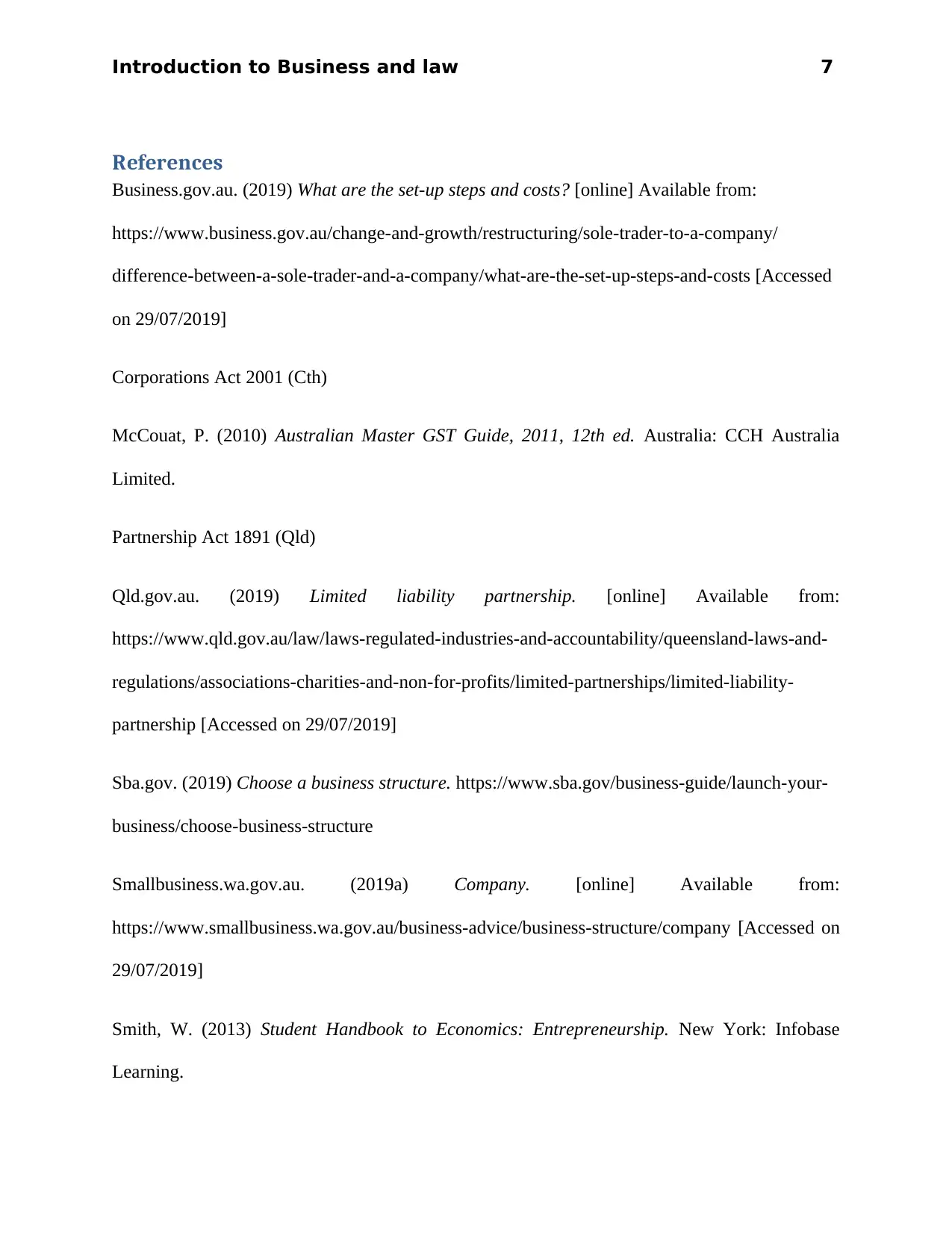
Introduction to Business and law 7
References
Business.gov.au. (2019) What are the set-up steps and costs? [online] Available from:
https://www.business.gov.au/change-and-growth/restructuring/sole-trader-to-a-company/
difference-between-a-sole-trader-and-a-company/what-are-the-set-up-steps-and-costs [Accessed
on 29/07/2019]
Corporations Act 2001 (Cth)
McCouat, P. (2010) Australian Master GST Guide, 2011, 12th ed. Australia: CCH Australia
Limited.
Partnership Act 1891 (Qld)
Qld.gov.au. (2019) Limited liability partnership. [online] Available from:
https://www.qld.gov.au/law/laws-regulated-industries-and-accountability/queensland-laws-and-
regulations/associations-charities-and-non-for-profits/limited-partnerships/limited-liability-
partnership [Accessed on 29/07/2019]
Sba.gov. (2019) Choose a business structure. https://www.sba.gov/business-guide/launch-your-
business/choose-business-structure
Smallbusiness.wa.gov.au. (2019a) Company. [online] Available from:
https://www.smallbusiness.wa.gov.au/business-advice/business-structure/company [Accessed on
29/07/2019]
Smith, W. (2013) Student Handbook to Economics: Entrepreneurship. New York: Infobase
Learning.
References
Business.gov.au. (2019) What are the set-up steps and costs? [online] Available from:
https://www.business.gov.au/change-and-growth/restructuring/sole-trader-to-a-company/
difference-between-a-sole-trader-and-a-company/what-are-the-set-up-steps-and-costs [Accessed
on 29/07/2019]
Corporations Act 2001 (Cth)
McCouat, P. (2010) Australian Master GST Guide, 2011, 12th ed. Australia: CCH Australia
Limited.
Partnership Act 1891 (Qld)
Qld.gov.au. (2019) Limited liability partnership. [online] Available from:
https://www.qld.gov.au/law/laws-regulated-industries-and-accountability/queensland-laws-and-
regulations/associations-charities-and-non-for-profits/limited-partnerships/limited-liability-
partnership [Accessed on 29/07/2019]
Sba.gov. (2019) Choose a business structure. https://www.sba.gov/business-guide/launch-your-
business/choose-business-structure
Smallbusiness.wa.gov.au. (2019a) Company. [online] Available from:
https://www.smallbusiness.wa.gov.au/business-advice/business-structure/company [Accessed on
29/07/2019]
Smith, W. (2013) Student Handbook to Economics: Entrepreneurship. New York: Infobase
Learning.
1 out of 8
Related Documents
Your All-in-One AI-Powered Toolkit for Academic Success.
+13062052269
info@desklib.com
Available 24*7 on WhatsApp / Email
![[object Object]](/_next/static/media/star-bottom.7253800d.svg)
Unlock your academic potential
Copyright © 2020–2025 A2Z Services. All Rights Reserved. Developed and managed by ZUCOL.


